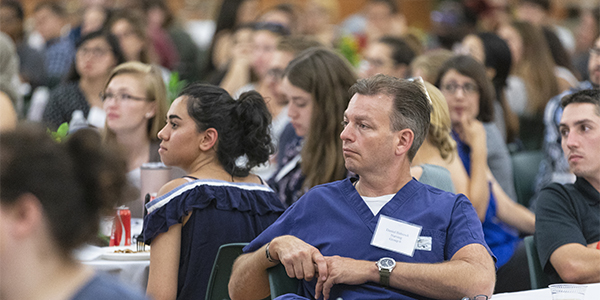Orientation kicks off a year of collaborating to improve patient care
University president urges students to work together

Twenty-eight interprofessional teams of pharmacy, nursing and social work students broke the ice with each other two days before fall semester classes began at Binghamton University.
The Interprofessional Education (IPE) orientation, held in the Mandela Room of the University Union, was larger than last year due to higher enrollments – demonstrated when Gloria Meredith, founding dean of the School of Pharmacy and Pharmaceutical Sciences, asked students to raise their hands by discipline. Eighty-four pharmacy, 81 social work and 56 nursing students raised their hands at the orientation where they learned what to expect over the next academic year as they work together to care for patients.
Last year, the IPE program created 13 teams of 12 students each. This year, teams have been reduced to eight or nine students.
Citing an estimate of one in three of students at Binghamton being new to the campus, President Harvey Stenger encouraged the team members to say hello and introduce themselves to others. “I can’t assume you know who I am, so think of that as you acclimate to campus,” he said. “Think of these people as your newfound friends.
“Interprofessional education is about relationships,” he said. “It’s not about who is in charge. To be part of a team – to be good and functional – simply work together. That’s the hardest challenge you will encounter.”
“It’s quite exciting to see all of you here this evening,” Meredith said. “We’re very excited about the IPE aspect of our program and have talked about it since before I arrived. It really is what will help you work in the healthcare industry.”
“Everybody got on board with IPE,” added Laura Bronstein, dean of the College of Community and Public Affairs. “You will ultimately feel like you have better outcomes when working together, but the process won’t be easy. However, when you go out on the job market, you’ll be really ready for practice in the 21st century. IPE will serve you well and is critical for any setting you’ll find yourselves in.”
Pam Stewart Fahs, associate dean of the Decker School of Nursing, spoke of IPE as being patient-focused. “As a healthcare provider, it’s critical to keep the patient front and center and you do that through open communication,” she said. “That’s why it’s great to see so many students here working toward interprofessional collaboration.”
Suk Young Kang, interim chair of the Department of Social Work, explained to students that they would be learning about, from and with each other through the year and there will be planned activities with students from SUNY Upstate Medical University as well.
“Why IPE?” he asked. “Because if we have this IPE model, we can lower the cost of healthcare and have better outcomes,” he said.
Students participated in group activities during the orientation as well.
The first, led by Erin Pauling, clinical assistant professor of pharmacy practice, had students thinking about team-based care for patients and clients. “As a group, why do you think IPE care is important to patients and clients?” she asked. Students then texted their responses to Pauling, who created a word cloud of the key themes.
The results? “Not surprisingly, patient is the largest word up there,” Pauling said. “We will be learning a lot about patient care as we move through our curriculum. Communication is also very important, as is thinking about the different perspectives of teams including the patient. You will not be a team around the patient, but with the patient.”
Nicole Rouhana, director of graduate nursing programs in the Decker School, told students a story involving a number of healthcare professionals who came together to assist a women giving birth in the hallway of a hospital with no physician present.
“I didn’t even have a conversation with the others,” she said. “We just had this unspoken communication going. I’m sharing this because when you work in IP groups and have that working relationship, you’ll know who has what strength.”
Rouhana conducted the second team activity, asking students how they keep an egg from breaking when dropped from a balcony. She then had them choose a healthcare scenario where the patient (the egg) must navigate from point A to point B. “What challenges might your patient/client face? What resources are needed to protect the patient/client during the navigation?
Of the dominant phrases that keep coming up, communication is the biggest one,” Rouhana said. “And insurance came up time and time again.”
The final activity asked students what they team identified as the most important resource to protect the patient/client during navigation of the healthcare system. Interprofessional communication topped the list.
Gail Rattinger, associate dean for academic affairs and assessment for the pharmacy school, explained to students how IPE fits into their curriculum.
“We looked at areas where our three programs have some synergy,” she said, ”so the first semester we’ll focus on health and behavioral healthcare delivery, and next semester there will be an interprofessional communications course,” she said. “The following year will include some ethics work as well as simulations.
“We want some of your key strengths to be able to work across the healthcare professions and to create teams of professional who have key strengths and who use those strengths to provide better outcomes for patients/clients,” said Rattinger.
“We’re hoping to reach the quadruple-A to add to what the president said about three-A (improved costs, improved outcomes and fewer errors), and that less burnout from healthcare professionals,” she said. “Those with less burnout have peers and colleagues to rely on through their specialties and that helps in terms of their satisfaction with their career choice.”
